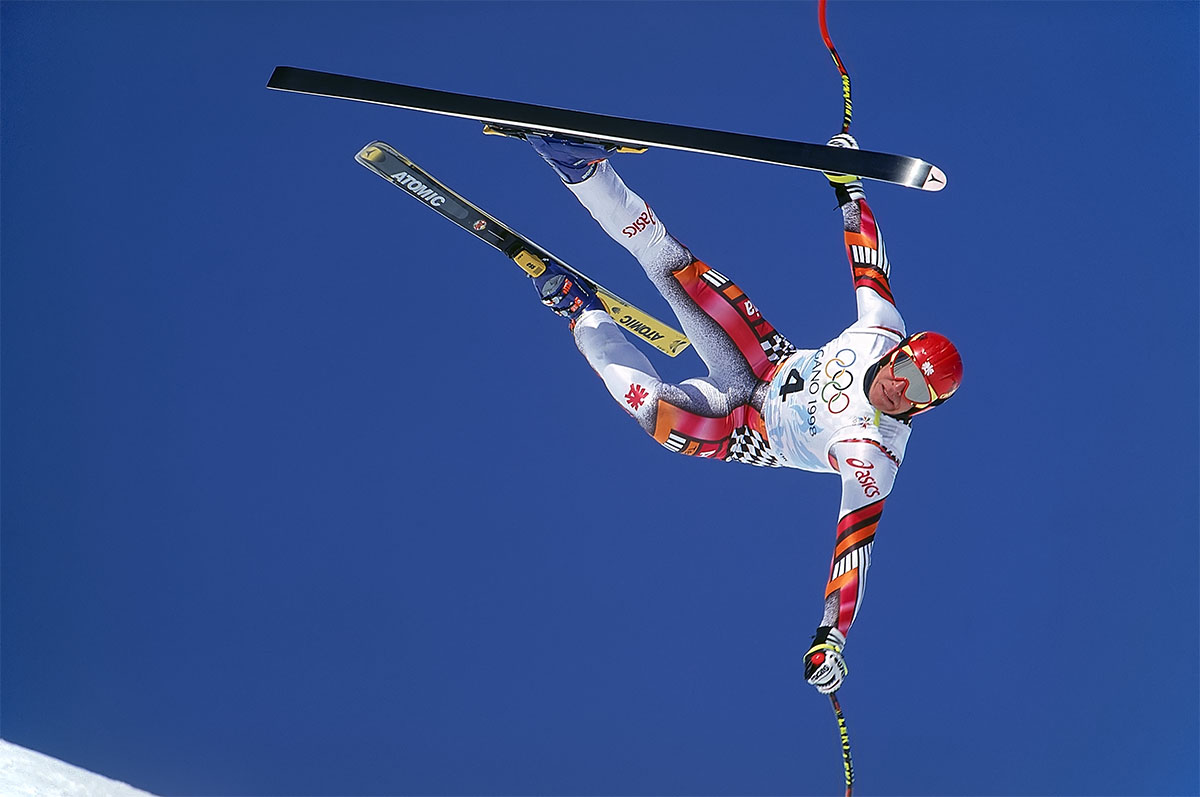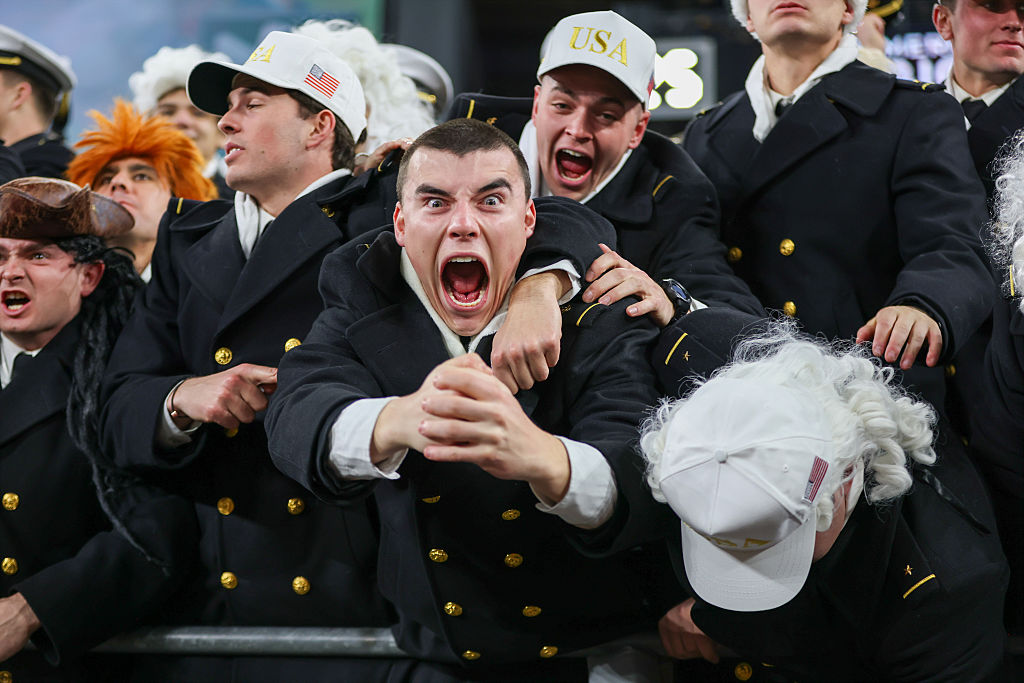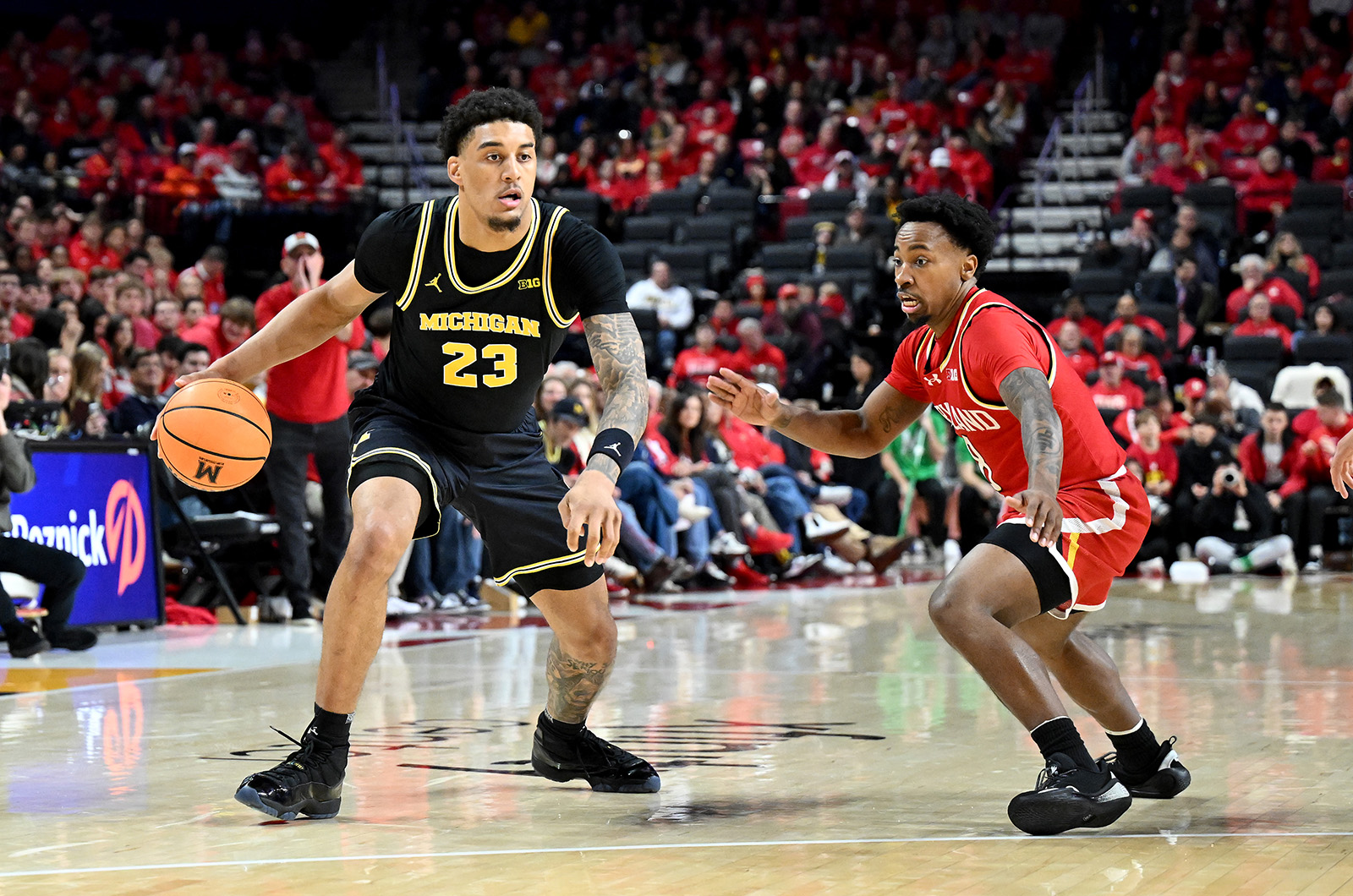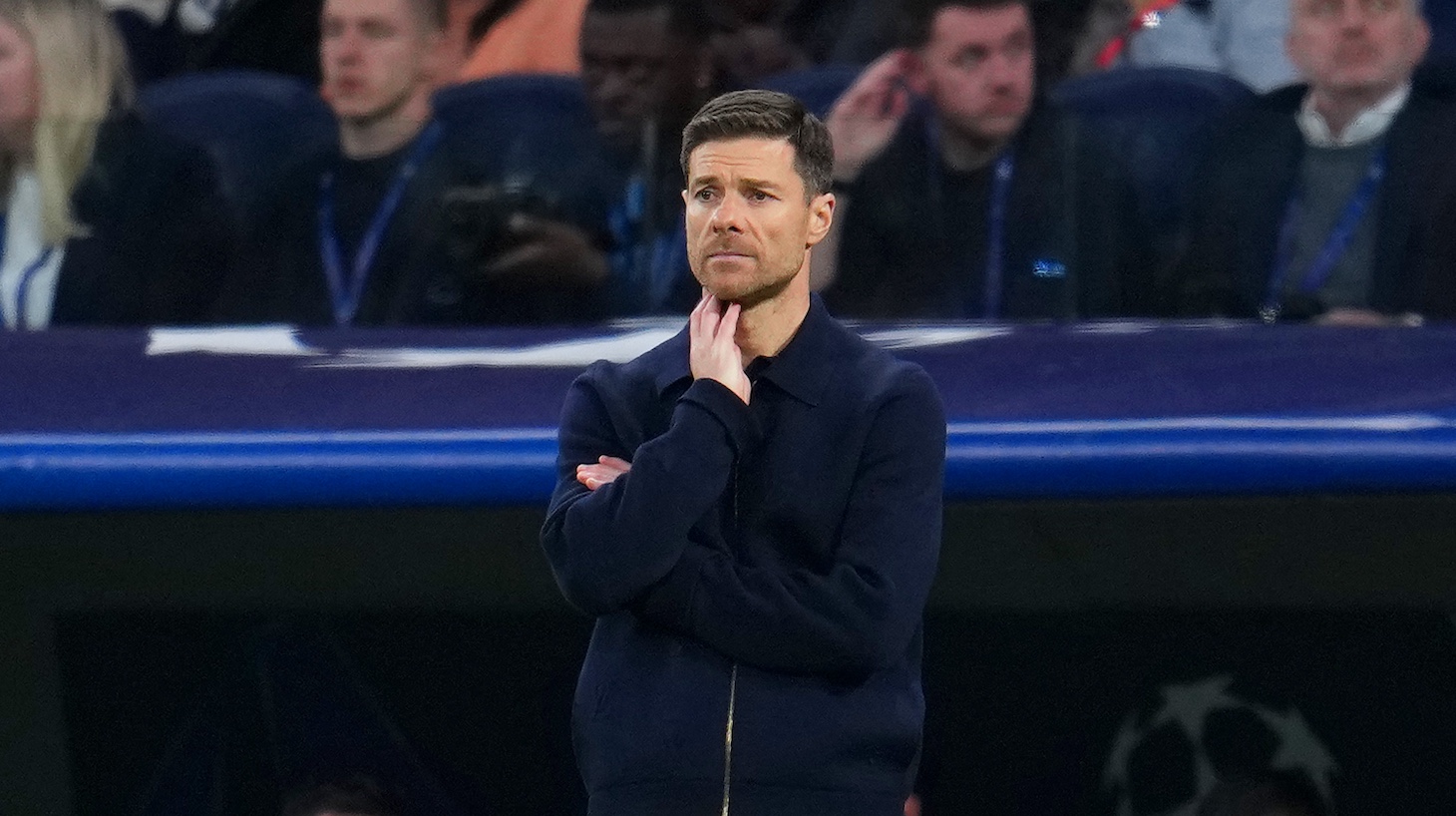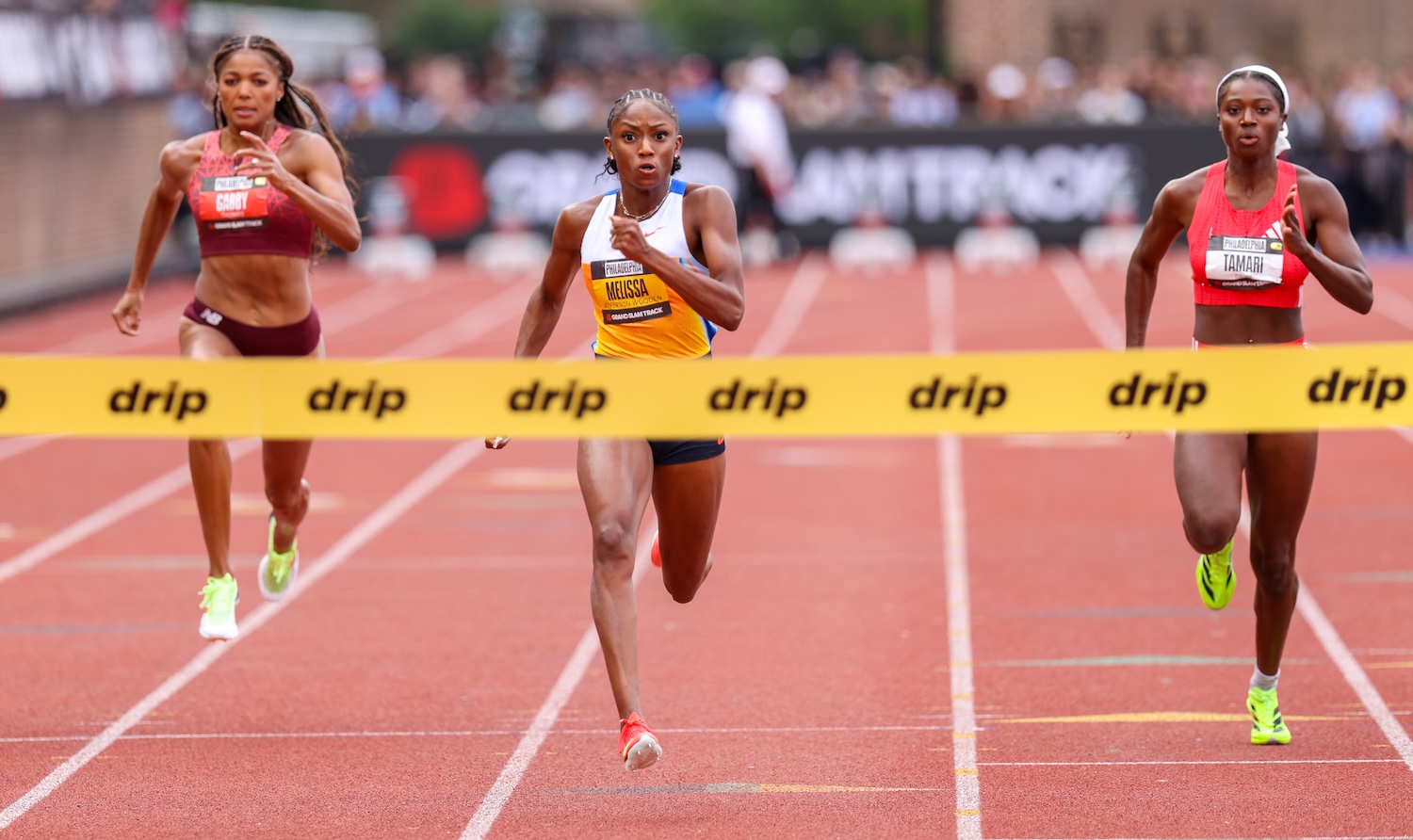In the run-up to the 1998 Winter Olympics, the media spotlight was focused on the chances of figure skater Michelle Kwan, the first appearance of NHL players in the men's hockey tournament, and the debuts of men’s and women’s snowboarding.
But alpine ski aficionados were raving about Hermann Maier, whose ferocious, no-holds-barred styling was dominating the World Cup circuit. The debate along Nagano’s main drag of Chuo-dori was, Would he win three gold medals or four?
Snow, sleet, rain, wind, and fog plagued the opening week of the Games, causing multiple postponements on the skiing schedule. Five days passed before bluebird conditions prevailed at the resort town of Hakuba. The most prestigious alpine event was on, finally, and Austrian fans wielding flags, horns, and wineskins packed the bowl around the finish line in anticipation of Maier’s downhill ascension.
Carl Yarbrough was an experienced ski-racing photographer who’d worked five Winter Olympics and countless World Cup races. On assignment for Sports Illustrated, he stayed at Hakuba through the weather delays and had scouted out a sweet spot high up the mountain, far from the other photographers, where he hoped to capture the skiers as they ratcheted up to 65–70 miles an hour. He secretly built a makeshift platform there so that he could shoot over a trio of safety nets that were designed to “catch” wayward skiers if they skidded off the course.
Yarbrough had left the previous Winter Olympics, in Lillehammer, without a single photograph being published in SI. He was so discouraged that he had vowed to skip Nagano. Instead, as Maier and the 42 other competitors, resplendent in multi-hued, skin-tight, one-piece suits, rode the chairlift up to the start, Yarbrough was back in “his office” on the mountain.
He hid behind the safety nets and surveyed the start list. In red ink he circled Maier’s name and bib number: “The Herminator” would ski fourth.
It was Friday the 13th. What could go wrong?
Born and raised in Texas, Carl Yarbrough glimpsed his future the first time his father took him to Taos, New Mexico. The conditions at one of the West’s premier ski resorts weren’t great that day, Yarbrough recalled, but he was “smitten” with skiing. “All I could do was think about it and dream about it,” he recalled.
After graduating with an anthropology degree from SMU, he enrolled at ArtCenter College of Design in Pasadena to study commercial photography. He worked summers as a mountaineering guide and, after two years in California, moved to Aspen. There, at one of the epicenters of U.S. ski racing, he combined his love of the outdoors and his creative bug by joining forces with a local photographer named John Russell. Along with colleagues John Kelly and Allan Laidman, their company shot adventure sports for outdoor magazines and commercial clients.
“John [Russell] basically handed me cameras I’d never shot before, and I think we surprised each other at how good I was,” Yarbrough said. “We both discovered that I had a real knack for stopping action.”
Yarbrough felt he’d reached nirvana. He was shooting the sports that he himself enjoyed doing: trail running in Peru, rock-climbing, hang-gliding, hot air ballooning, windsurfing, kayaking, sailing, cycling, and sand skiing. He once rented a station wagon, strapped himself atop the roof rack and, while his driver hit 100 miles an hour on a banked track, took pictures of racers at Talladega Speedway.
Most of all, he relished the physical, mental, and artistic challenges that come with photographing skiing, especially in the era before digital cameras. “I’ve never seen any sport that is harder to shoot,” he told me, before ticking off the trials and tests of the craft.
First and foremost, the humility and patience necessary to deal with the ever-changing natural elements. Try loading a roll of film into a camera as punishing winds, sub-freezing temperatures, and swirling sleet turn your fingers into icicles.
Yarbrough spent hours before every race scouring the terrain for the optimal position. “I’d try to pre-visualize what the skiers will be doing and where,” he said. “Are they in a tuck here? Are they going to get in the air here? If it’s a place where I think there’ll be good action, I’ll ski a little lower and turn around to see what the background looks like. Is it a dark sky? Are they going to be in the sun? Is there going to be a billboard that I don’t want in the picture?”
Then there’s the equipment. On the days the skiers took their training runs, Yarbrough would strap on his skis, ride the lift to the top, then meticulously inspect the course for a good spot. All the while, he was lugging a 50-pound pack filled with at least two camera bodies (always have a backup!), a cache of behemoth lenses, 100 rolls of film, and miscellaneous tools. “You’re carrying all that stuff and you’re side-slipping because the course is as hard as asphalt,” he said. “I would have crampons with me and ropes to jumar into trees and get a better angle.”
Yet more challenges involved playing cat-and-mouse with other photographers who stalked his trail, and dodging stern Olympic and FIS officials who seemingly lived to shoo him from ideal locations. “They hate your guts,” he said. “They’re always moving you off the course.”
For the downhill competition, Yarbrough noted, “You’ve got guys going 70–80 miles an hour. The very best skiers come first, and you get one shot. Tell me any other sport where you get one shot at it. … The pressure that day—you can just feel it in the air. Everybody’s trying to get that one shot.”
Yarbrough established himself on the international ski circuit, long before the average American sports fan had ever heard of the Streif at Kitzbühel or the Lauberhorn at Wengen or Kandahar at Garmisch-Partenkirchen. Europeans dominated at the Olympics and in the World Cup standings (and with endorsements), but U.S. alpine skiing hopes were rising behind the twin-brother combination of Phil and Steve Mahre.
In 1980, Yarbrough shot his first Winter Olympics, at Lake Placid in upstate New York, with Phil Mahre taking the silver medal in the slalom. Sports Illustrated took notice and began using Yarbrough’s pictures for the magazine’s quadrennial Olympic preview issues, which in their glossy-print heyday exceeded 300 pages, and gave him assignments at Sarajevo (1984), Calgary (1988), Albertville (1992), and Lillehammer (1994).
By then Yarbrough had moved to Boulder and launched his own business, shooting for commercial clients like Mountain Dew and resort properties. But his passion remained with skiing and, by extension, ski-racing photography for editorial clients like SI. “I was hired to shoot the stuff that their staff guys didn’t know how to shoot,” he said.
Yarbrough’s experience at Lillehammer left him questioning his own expertise. Everything that could’ve gone wrong did. He contracted a stomach bug. His cameras malfunctioned, and film got shredded on account of the cold weather. Then, just 15 minutes before the start of the downhill, an official inexplicably forced him to move from his position—and caused him to miss getting a shot of American Tommy Moe, the eventual winner.
In a profession where you’re only as good as your last good photo, Yarbrough was “crushed,” he said. “I was decimated and feeling kind of worthless. I left that Olympics saying, ‘That’s it. I’m done.’”
Four years later, when SI called Yarbrough about shooting for them in Nagano, he initially declined. He credits Steve Fine, SI’s longtime Director of Photography, with changing his mind. “Steve was very gracious to say, ‘Look, we know everyone has bad days.’”
On the flight to Japan, Yarbrough comforted himself with the spiritual musings of Dutch theologian Henri Nouwen. “I’m paraphrasing, but he basically said, if you let your life be defined by your failures or your successes, you’re setting yourself up for depression, anxiety, and all kinds of problems. I remember sitting there after reading that, and finally being OK with what happened [in Lillehammer].”
Yarbrough stayed in a hotel in Hakuba, located in the Japanese Alps about 40 miles west of Nagano. The men’s downhill was scheduled for the day after the opening ceremony, so there wasn't much time to prepare for the marquee alpine event. As the competitors took their requisite training runs, Yarbrough skied the course and checked out different shooting positions. He found two that he considered viable.
One, toward the bottom where there was a nice jump, was a “duck shoot,” he said. “Basically, you got off the [lower] chairlift, walked 30 yards, pulled out your camera along with a whole slew of other photographers, and—BRRRPT! BRRRPT! BRRRPT!—it’s the easiest shot in the world.”
To escape the scrum and find a unique vantage point, Yarbrough staked out a position high up the mountain. The spot was opposite where the skiers, having gotten fully up to speed and into their tucks, attacked the first technical section of the course: a sweeping right-hand turn and then a sharp, steep left-hand turn. “I was anticipating shooting them when they were setting their edges, just before the hard left,” he said. “There was nobody else there, and that was a big part of it. I’m trying to get something no one else was going to get.”
Yarbrough planned to sneak behind three so-called “B nets”—seven-foot-high plastic safety nets designed to slow down errant racers—so that he could avoid pesky course officials. “I liked the action,” he said. “I thought it was good. I said to Steve Fine, if it’s a blue sky, it’s going to be good.”
To give himself a boost so that he could see above the netting, Yarbrough bought a small stepladder at the village hardware store and ferried it up the mountain. The flimsy legs sank in the snow, so Yarbrough swiped a 4x4 piece of plywood from an abandoned construction site next to the course and built a small platform.
“All I wanted was for my head to be over the fence,” he said. “I didn’t want to have to be standing on tiptoe in my ski boots.”
Nature intervened. First snow and poor visibility delayed the race, then fog and rain. Three times the downhill was pushed back. But with better conditions on Friday, officials readied the course, which was now fast and slick.
The clear favorite under those conditions was Hermann Maier. “He’s blowing everybody away on the most difficult sections,” U.S. skier Kyle Rasmussen told SI staff writer Tim Layden in an article published less than two weeks before the downhill. “The steeper it gets, the icier it gets; where everybody else holds back, he just charges right through. You watch him diving into some turns and you say, Wow, I’m not sure I could do that.”
The son of a ski-school owner, the 25-year-old Maier was something of a late bloomer. Cut from the national team as an undersized teen, he spent seven years apprenticing as a bricklayer before arriving as an unstoppable force during the 1997–98 FIS season. He recorded 10 World Cup wins before Nagano, and schuss-loving Austrians viewed him as a worthy heir to the likes of Karl Schranz, Franz Klammer, and Annemarie Moser-Pröll.
The morning of the downhill, with the sun shining in a cloudless sky, Yarbrough yielded the lower spot to Bob Martin, another shooter for SI, and ascended to the upper position. He arrived three hours before the race to find that his platform was buried beneath several feet of wet snow. He stripped off his coat and, in shirtsleeves, shoveled out the spot and reconstructed his platform. Then, he said, “I sat behind all the fencing and basically hid from the officials.”
As the start time neared, he experimented by photographing the forerunners, the group of skilled skiers who test the course before the race and help set the line for the competitors. Yarbrough liked the action, but he felt that being even higher might give him a superior shooting angle.
So, he carved out a second platform, located about 10 feet farther up from the original one. “It took me a good 30 minutes to pile the snow up and get another platform made,” he said. “I didn’t know which one I was going to use, but they were both ready to go.”
He returned to the first platform and loaded Fuji Velvia 100 film into a Canon high-speed camera that shot 14 frames per second. Attached to that was a 500-millimeter Nikon lens. Auto-focus wasn’t an option back then; Yarbrough relied on a technique he called “zone focus.”
“You pick a focal point on the snow and you lock the focus there,” he explained, “and then when you shoot [with a motor-drive], you let the skier drift through the focal plane. So, if you shoot eight frames, you’re only going to get one that’s perfectly sharp. The picture before can be almost in focus, the picture behind can be almost in focus, but all you care about it is that one shot, that one frame.”
About all he could see from his perch was a 30-degree window into blue sky and a single gate on the course. He would have to sense their approach by ear: When he heard the distinctive edges-skidding-on-packed-ice sound that racers make when they’re shredding, that meant they were about to reach his viewfinder—and that was the signal for him to blast his motor-drive: BRRRPT.
The first three skiers generated “boring” pictures, according to Yarbrough. “Nothing special.” Maier was next.
With a two-minute window before the Austrian ejected himself from the start house, Yarbrough switched to a 400-millimeter lens—“because I wanted him closer to me”—and clambered up to the higher platform. He glanced at the film-counter on the camera, which indicated that he had only six frames left on the 36-exposure roll.
“Now I’m ready to go,” he recalled. “Here’s the guy who’s supposed to win the gold medal. Just pure concentration: I’m listening to hear him turn above the gate—waiting, waiting, waiting—but I never heard him scrape the snow. Next thing I know, there’s this human projectile in a white suit coming straight at me.
“He’s fully airborne when I first see him, and I just blast away. BRRRPT.”
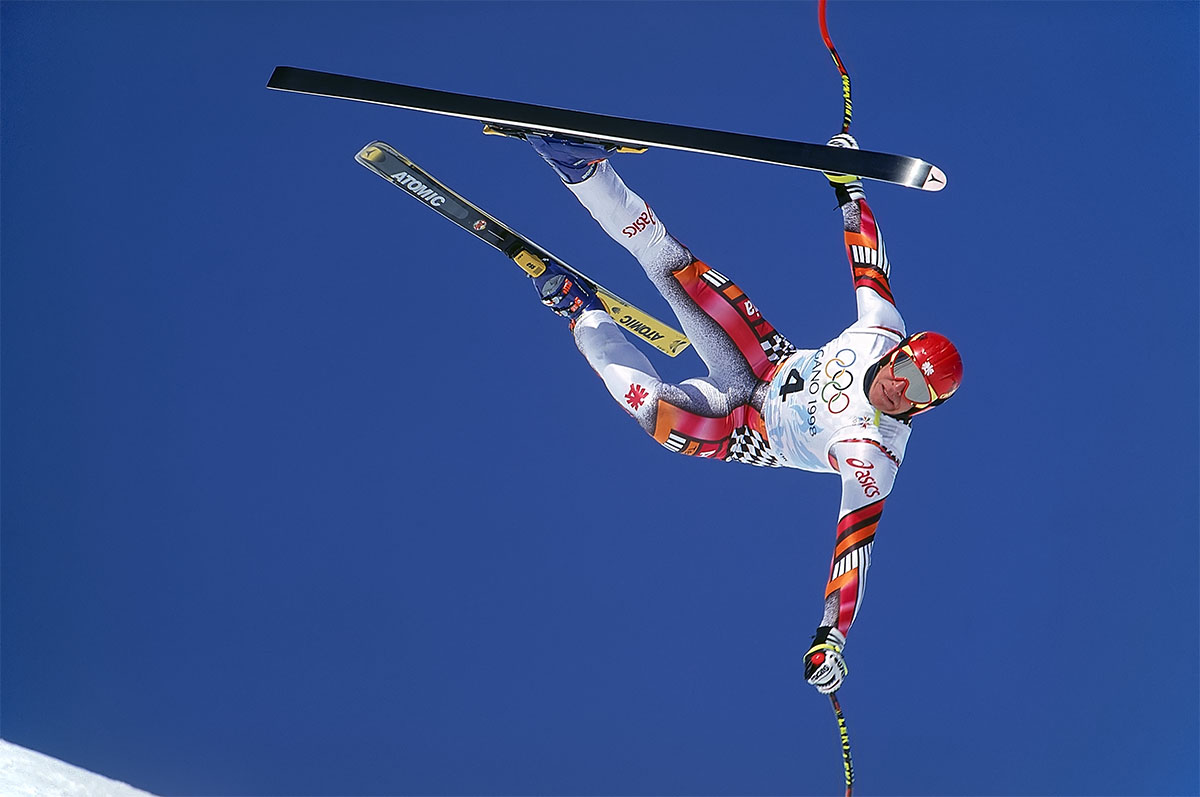
Was it Maier’s balls-to-the-wall approach that doomed him? Did he misjudge the speed of the course after the numerous delays? Or, did the officials move the original location of the gate, as some have alleged, thus throwing off his timing?
No matter the reason, having gotten into his tuck and reached 75 miles per hour in less time than it takes Usain Bolt to run 200 meters, he missed the abrupt left turn and became Air Maier. A tailwind complicated his travails as he sailed off course. He hovered upside down briefly before landing heavily on his back and neck, skis flying helter-skelter. He pinwheeled through the safety nets, came to a rest with his be-goggled face submerged in deep snow, and lay motionless for several nerve-wracking moments.
After shooting the crash sequence, Yarbrough watched Maier plow through the fencing and cartwheel over the lower platform. (At the 26-second mark of the video above, you can see Yarbrough's boots at the top of the screen as he scampers out of the way.) He said Maier looked “like a rag doll” when he came to rest about 70 feet down the mountain from Yarbrough.
“I was like, ‘Oh my God. I’m going to have to use my mountaineering first-aid and go rescue this guy,’” Yarbrough remembered. “He was this lump in the snow. But I see him start to move and he kind of was trying to loosen up his elbow. I shouted at him, ‘Are you OK’ in my broken German, and he sort of nodded his head. And I went, What a relief.”
An Austrian official came to collect Maier and assist him from the mountain. Yarbrough greeted them as they passed with more broken German: “Unglaublich photo!” Or, “Incredible photo!”
Of course, in the pre-digital era, Yarbrough couldn’t be certain that he had captured the crash. He carefully removed the film from the camera, loaded another roll, and shot the rest of the competition, won by France’s Jean-Luc Crétier (who had skied third, just before Maier).
All the while, Yarbrough recalled, “I was thinking, ‘Did I get the shot?’ I felt pretty good about it, but you never know.”
Yarbrough was assigned to shoot the hastily rescheduled men’s combined downhill event that afternoon. But the possibility that he had captured the crash took precedent and, immediately after the downhill, he skied down the hill and handed his film to Steve Fine, who rushed it to Nagano for processing. Yarbrough went out drinking with other photographers and journalists in Hakuba Village, figuring, “Either I’m going to be crying because I missed it or else I’ll be celebrating.”
Fine called him from Nagano later that day. “I’ll never forget it,” Yarbrough said. “He said, ‘Carl.’ I was in agony waiting. He said, ‘You fucking nailed it!’”
Yarbrough laughed. “Drinks all around!”
Meanwhile, Maier’s disastrous wipeout was being endlessly replayed on TV. It instantly drew comparisons to the ignominious “agony of defeat” crash, starring the immortal Slovenian ski jumper Vinko Bogataj, in the spanning-the-globe opening to ABC’s long-running Wide World of Sports.
Other observers saw the epic within the moment. Maier’s crash was “an anarchic burst of kinesis that refreshed our understanding of why alpine skiing is so exciting to watch in the first place,” wrote author Hampton Sides in Outside magazine. “The possibility of pure, white-knuckled calamity, the chaos lurking just behind the scrim of mastery and finesse.”
Days later, when Yarbrough journeyed to Nagano, he was finally able to view his handiwork. Inside the main press center was his photo of Maier in extremis, blown up to oversized dimensions.
“I was like, ‘Oh my God, I shot that!?’” Yarbrough said. “After feeling so defeated four years earlier, with not getting a picture published, to see this was just overwhelming. You could say it was luck, but I remembered something that Heinz [Kluetmeier, former Director of Photography at SI] once told me, ‘You make your own luck.’ And he’s so right. There’s all the prep and all the time and all the pre-visualization you put into it. Pushing the button is less than one-half percent of the job.”
He paused and then laughed. “But you still have to press the damn button!”
What happened three days later cemented the legend of the Herminator. After some rest, treatment, ice, and painkillers, Maier returned to the scene of the crash. Despite soreness and a right knee strain, he won the super-G at Hakuba. (The super-G course began just below the crash site.) Then he won the giant slalom at Shiga Kogen. He’d won two gold medals, not four, as some had predicted, but the crash and his miraculous comeback probably made him even more famous than any number of golds could have. (Later that year, he won the World Cup overall title.)
By then, Yarbrough’s photograph was being hailed as an indelible masterpiece: the gnarliest ski-crash picture ever taken and one of the most memorable pictures in Olympic history. Untethered in flight, in stark relief against what looks to be an artificial backdrop but is actually the bluest of Japanese skies, Maier’s face is frozen in a tight-lipped grimace. His goggles reflect the hard white surface that is rushing to punish him, while his outstretched arms and poles point to 12 and 6. (Perhaps most importantly, his red crash helmet remains firmly attached to his large head.)
In the full-frame version of the photo, the blue-ness spreads across the horizontal plane and a tiny triangle of snow peaks from the lower left. Maier appears adrift, like an astronaut navigating a spacewalk. For the tightly cropped SI cover, Maier looks like he’s about to crash into the reader’s lap. Beyond its sheer artistry, the image also supplies breaking-news, just-the-facts-ma’am context: The full-frontal exposure of the Olympic rings and “Nagano 1998” as well as Maier’s bib number, his sponsors’ branding, and the Austrian emblems.
As it turned out, Yarbrough’s double-truck layout of American Picabo Street winning the super-G was published in the same issue as the Maier cover, as were his photos of two other downhill skiers flying off the course. And, in another sign that his fortune had changed for the better, the film-counter on his camera had been incorrect: He actually had eight frames left on the roll, not six, giving added scope to the Maier sequence. Redemption, indeed.
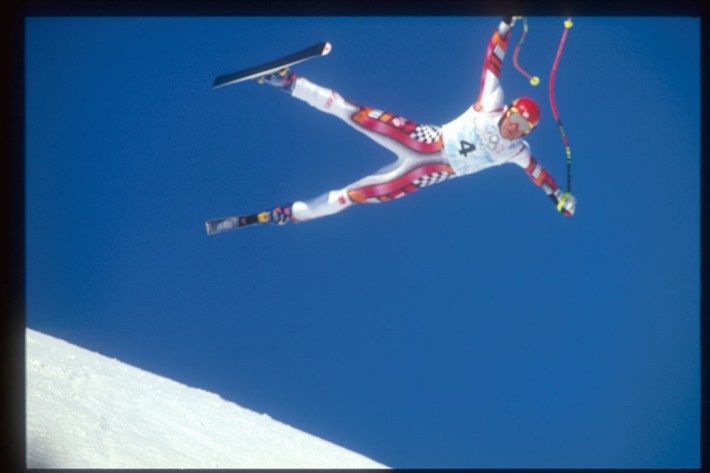
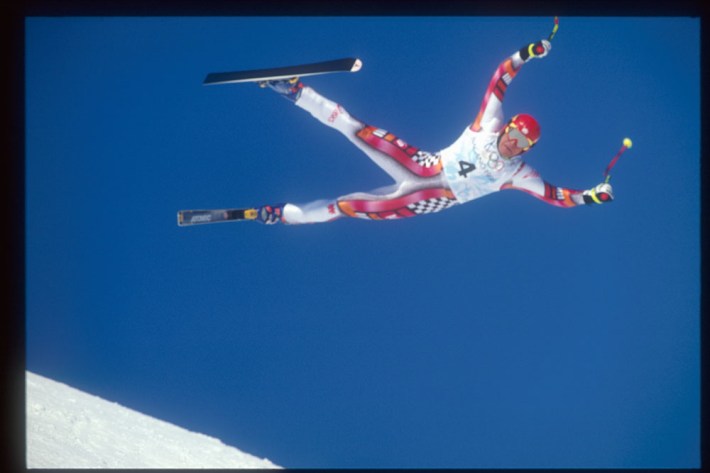
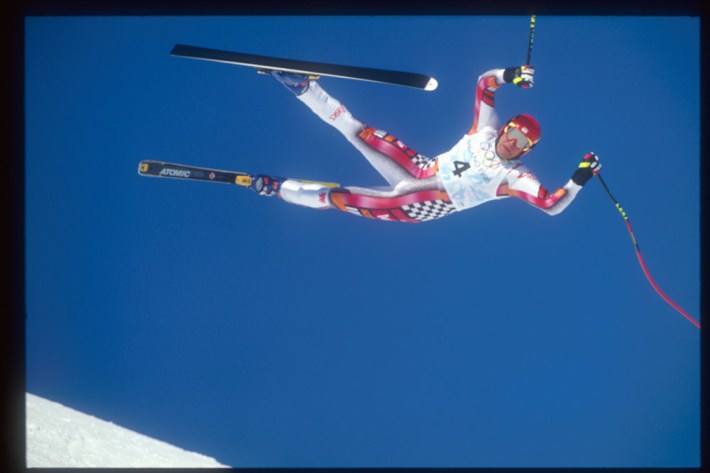
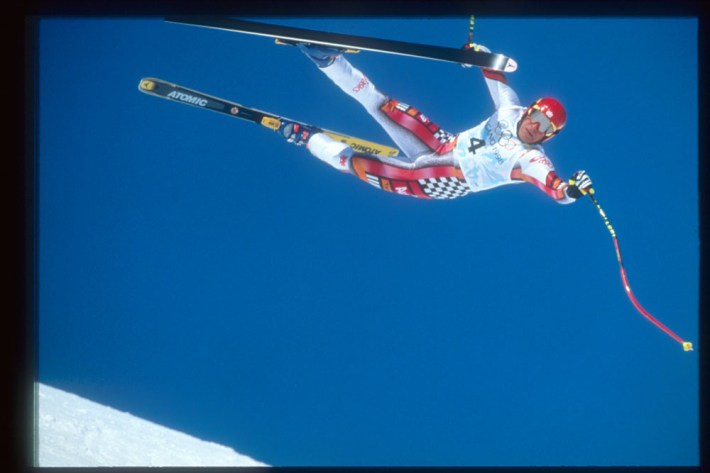
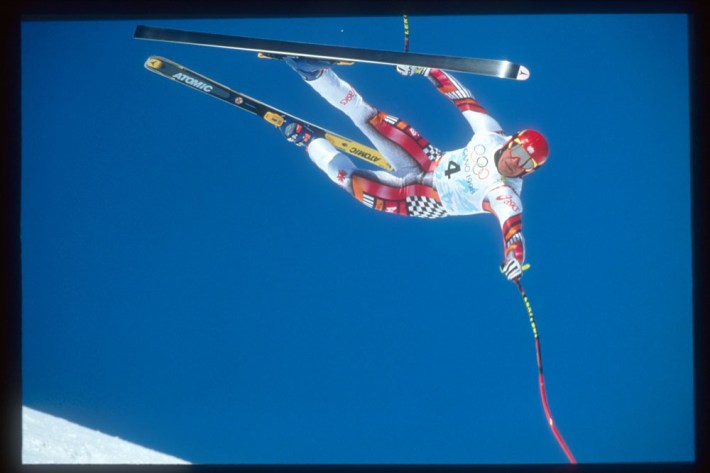
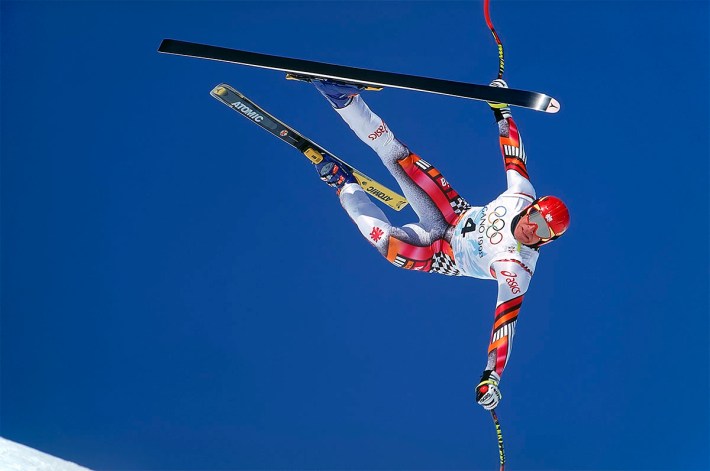
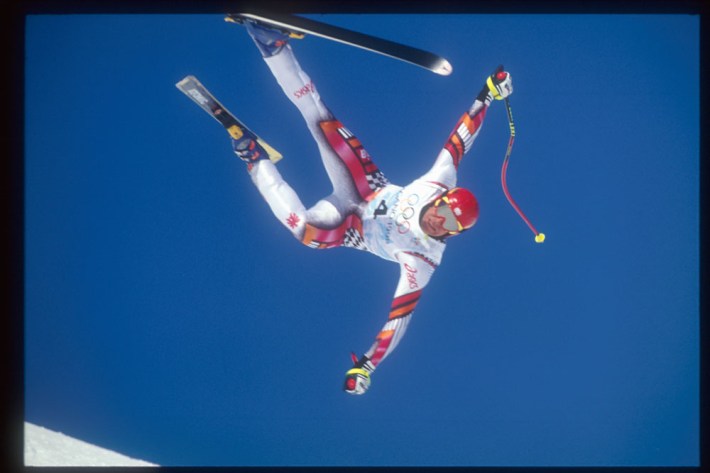
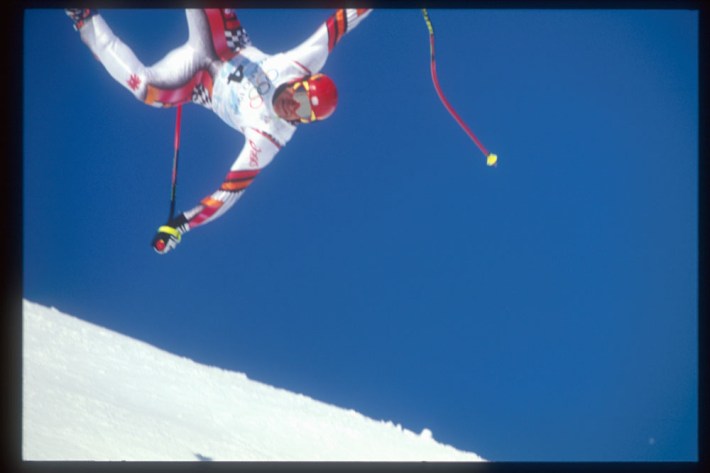
I can still remember the first time I saw the cover. I had fortuitously scored a last-minute gig working for CBS’s research department in Nagano. It was the final Olympics for which CBS owned the TV rights in the U.S.—it’s been exclusively NBC ever since—and so while our group of jetlagged misfits bonded over tasty bowls of soba and late-night beers, morale among the suits and the talent in the press center was very low.
My immediate supervisor was journalist-author Julian Rubinstein (The Holly; The Whiskey Robber). Julian had previously worked for Sports Illustrated and through his connections had gotten ahold of a precious early copy of the cover that he showed to the rest of us. We’d all watched endless TV replays of Maier’s ill-fated run and been blown away that he’d walked away unscathed; now we found ourselves astonished at the unadulterated visual drama of Maier’s predicament.
The crash photo has been reproduced countless times since Nagano, including in Maier’s autobiography, The Race of My Life (2004), and in Ski Magazine’s “Greatest Photos of the Century” spread (1999). In 2016, the photo was featured in the landmark “Who Shot Sports: A Photographic History, 1843 to the Present” exhibition at The Brooklyn Museum, curated by Gail Buckland, as well as in her encyclopedic companion book.
As film gave way to digital, Yarbrough returned to shoot the 2002 Salt Lake City Olympics (which Maier missed after nearly losing his right leg in a motorcycle accident) and the 2006 Turin Olympics (where Maier won a silver medal and a bronze medal). The 2010 Vancouver Games was Yarbrough’s last Olympic hurrah.
By then, the physical demands of hauling heavy equipment up and down mountainous terrain, in summers and winters, had wrecked havoc on his body: torn rotator cuffs, worn-out knees, 21 surgeries. He no longer shoots professionally, but says he “still loves photography” and “cannot go anywhere without a camera.”
Yarbrough, now 65 years old, continues to live in Colorado. Two recent knee-replacement procedures have re-energized him and he can enjoy skiing and cycling once again. His creative bent has expanded beyond photography. He started using old bicycle parts to make lamps and objects for friends. And together with his son Sean, he crafts oversize steel public sculptures that are displayed around the state.
“I’m an artist,” he said, “and art is very personal to me. I have to be creating. My journey now is, my son and I are doing these really large public displays.”
Some 24 years after Nagano, as Beijing takes its turn in the Olympic spotlight, Yarbrough still savors the Maier moment. “There’s no question it was the culmination of 20 years of shooting ski racing, working my butt off, taking pictures no one’s ever seen,” he said. “It just happened that day I hit it out of the park, man. Sometimes luck shines upon you.”
